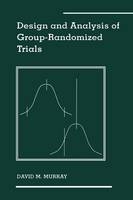
Design and Analysis of Group-Randomized Trials
Oxford University Press Inc (Verlag)
978-0-19-512036-3 (ISBN)
This is the first comprehensive text on the design and analysis of group-randomized trials. It It collects information previously scattered among journals and texts in a variety of disciplines, and, in addition, presents much new material not available elsewhere. The book has been written to help those involved in these trials improve their ability to plan, fund, conduct, analyse, and interpret them, and to give students a detailed understanding of the field.
Group-randomized trials are comparative studies in which the units of assignment are identifiable groups and the units of observation are members of those groups. The positive intraclass correlation expected among the members of each group poses unique and challenging issues for the design and analysis of these trials and separates them from the traditional clinical trial. After reviewing the underlying issues, Murray presents the research designs that are most widely used in group-randomized trials, together with their strengths, weaknesses, and appropriate applications. He describes the many approaches to analysis that are now available, presents mixed-model regression analyses appropriate to each design, and illustrates them using data from the Minnesota Heart Health Program. He also covers methods for estimating sample size, detectable difference, and power. This volume is not limited only to a conceptual treatment of the issues and solutions. It offers a review of the practical applications in a series of case studies, examples, and problems.
David M. Murray has spent his career evaluating intervention programs designed to improve the public health. Beginning in the late 1980s, Dr. Murray focused on the design and analysis of group-randomized trials to assess the effect of an intervention. Dr. Murray served as the first Chair of the Community-Level Heath Promotion study section, which reviews many of the group-randomized trials submitted to NIH. After 35 years at the University of Minnesota, the University of Memphis, and the Ohio State University, Dr. Murray joined the NIH in September 2012, as the Associate Director for Prevention and Director of the Office of Disease Prevention. He is responsible for promoting and coordinating prevention research among and between NIH Institutes and Centers and other public and private entities.
1. Introduction ; 2. Planning the Trials ; 3. Research Design ; 4. Planning the Analysis ; 5. Analysis for Nested Cross-Sectional Designs ; 6. Analysis for Nested-Cohort Designs ; 7. Applications of Analyses for Nested Cross-Sectional Designs ; 8. Applications of Analyses for Nested-Cohort Designs ; 9. Sample Size, Detectable Difference and Power ; 10. Case Studies
| Erscheint lt. Verlag | 19.3.1998 |
|---|---|
| Reihe/Serie | Monographs in Epidemiology and Biostatistics ; 27 |
| Zusatzinfo | line figures and tables |
| Verlagsort | New York |
| Sprache | englisch |
| Maße | 240 x 165 mm |
| Gewicht | 830 g |
| Themenwelt | Medizin / Pharmazie ► Gesundheitswesen |
| Studium ► Querschnittsbereiche ► Epidemiologie / Med. Biometrie | |
| Studium ► Querschnittsbereiche ► Prävention / Gesundheitsförderung | |
| ISBN-10 | 0-19-512036-1 / 0195120361 |
| ISBN-13 | 978-0-19-512036-3 / 9780195120363 |
| Zustand | Neuware |
| Haben Sie eine Frage zum Produkt? |
aus dem Bereich


